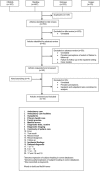Failure to follow-up test results for ambulatory patients: a systematic review
- PMID: 22183961
- PMCID: PMC3445672
- DOI: 10.1007/s11606-011-1949-5
Failure to follow-up test results for ambulatory patients: a systematic review
Abstract
Background: Serious lapses in patient care result from failure to follow-up test results.
Objective: To systematically review evidence quantifying the extent of failure to follow-up test results and the impact for ambulatory patients.
Data sources: Medline, CINAHL, Embase, Inspec and the Cochrane Database were searched for English-language literature from 1995 to 2010.
Study selection: Studies which provided documented quantitative evidence of the number of tests not followed up for patients attending ambulatory settings including: outpatient clinics, academic medical or community health centres, or primary care practices.
Data extraction: Four reviewers independently screened 768 articles.
Results: Nineteen studies met the inclusion criteria and reported wide variation in the extent of tests not followed-up: 6.8% (79/1163) to 62% (125/202) for laboratory tests; 1.0% (4/395) to 35.7% (45/126) for radiology. The impact on patient outcomes included missed cancer diagnoses. Test management practices varied between settings with many individuals involved in the process. There were few guidelines regarding responsibility for patient notification and follow-up. Quantitative evidence of the effectiveness of electronic test management systems was limited although there was a general trend towards improved test follow-up when electronic systems were used.
Limitations: Most studies used medical record reviews; hence evidence of follow-up action relied upon documentation in the medical record. All studies were conducted in the US so care should be taken in generalising findings to other countries.
Conclusions: Failure to follow-up test results is an important safety concern which requires urgent attention. Solutions should be multifaceted and include: policies relating to responsibility, timing and process of notification; integrated information and communication technologies facilitating communication; and consideration of the multidisciplinary nature of the process and the role of the patient. It is essential that evaluations of interventions are undertaken and solutions integrated into the work and context of ambulatory care delivery.
Figures
Comment in
-
Test results follow-up: a systematic review.J Gen Intern Med. 2013 Feb;28(2):175. doi: 10.1007/s11606-012-2281-4. J Gen Intern Med. 2013. PMID: 23179972 Free PMC article. No abstract available.
-
Test result follow-up: a systematic review.J Gen Intern Med. 2013 Feb;28(2):174. doi: 10.1007/s11606-012-2278-z. J Gen Intern Med. 2013. PMID: 23229909 Free PMC article. No abstract available.
-
Ambulatory test result follow-up represents a serious problem and solutions are needed.Evid Based Med. 2013 Oct;18(5):197-8. doi: 10.1136/eb-2012-101119. Epub 2013 Jan 26. Evid Based Med. 2013. PMID: 23355645 No abstract available.
References
-
- Hickner JM, Fernald DH, Harris DM, Poon EG, Elder NC, Mold JW. Issues and initiatives in the testing process in primary care physician offices. Jt Comm J Qual Patient Saf. 2005;31(2):81–89. - PubMed
-
- World Alliance for Patient Safety. World Health Organisation. Summary of the Evidence on Patient Safety: Implications for Research. In: Jha A, ed; 2008:1–118.
-
- Schiff GD.Getting Results—Reliably Communicating and Acting on Critical Test Results: Joint Commission Resources; 2006.
-
- Elder NC, Graham D, Brandt E, Dovey S, Phillips P, Ledwith J, et al. The Testing Process in Family Medicine: Problems Solutions and Barriers as Seen by Physicians and Their Staff. A study of the American Academy of Family Physicians' National Research Network. J Patient Saf. 2006;2(1):25–32.
Publication types
MeSH terms
LinkOut - more resources
Full Text Sources
Other Literature Sources
Medical
Miscellaneous



